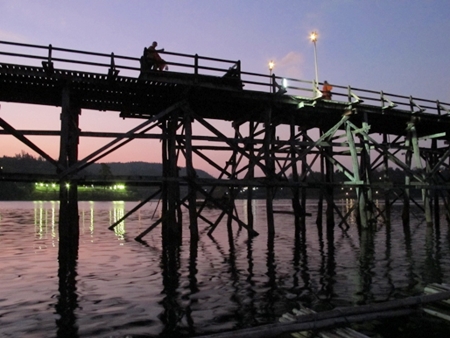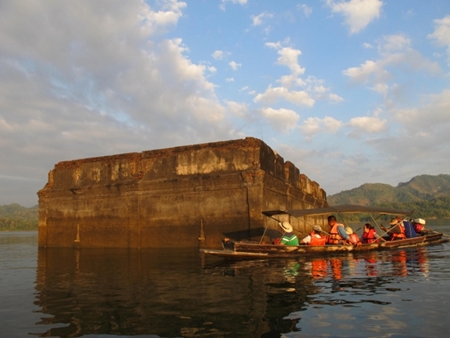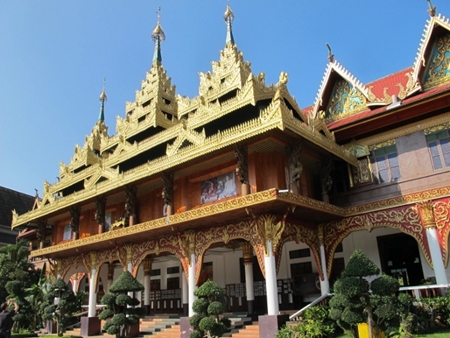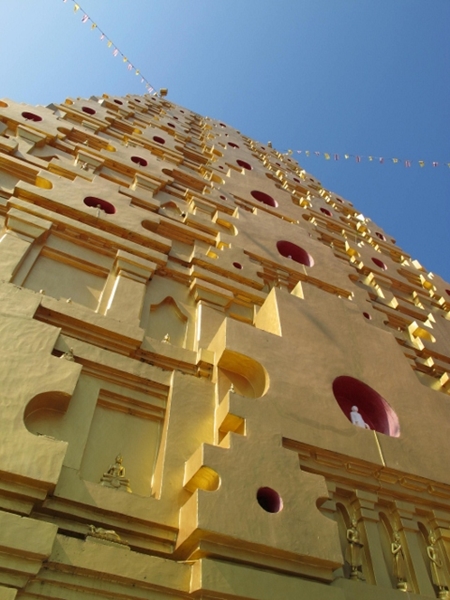Though a small and sleepy rural town in the western Thai province of Kanchanaburi, Sangkhlaburi has always enchanted visitors with its rich history and wide range of diverse ethnic cultures.

The Three Pagodas Pass, Sangkhlaburi
When travelling in and around Kanchanaburi, visitors have plenty of choices to enjoy fascinating days out. Most choose to explore the province’s natural gems; such as, the national parks with their stunning waterfalls; others take time to see the cultural, historical or architectural sites. But one little town that offers the best blend of everything is the idyllic little destination of Sangkhlaburi. This faraway border region which for centuries has linked Thailand and Myanmar can be found approximately 360 km from Bangkok or 230 km from Kanchanaburi’s urban centre.
These are long distances, so you face an epic drive to the Sangkhlaburi district, even from Kanchanaburi town itself. So this rather remote destination tends to attract only the most determined of travellers. But those who do come consider it well worth the trip. For while the road itself is long, it certainly is not a tiresome journey. The route is wonderfully scenic and there are many chances to enjoy the unique cultures and attractions along the way.

The famous Mon Bridge
The people of Sangkhlaburi are made up of various ethnic groups, including the Mon, Burmese and certain Karen groups. And though many visitors find that the locals can converse in Thai, and all have irrepressible Siamese smiles, many of them are not Thai citizens; or have only recently been given Thai citizenship or ID cards. So the area is a melting pot of different cultures with Sangkhlaburi being home to the kingdom’s largest groups of ethnic communities.
Some 40 years ago, the valley in which Sangkhlaburi lies was home to the local Mon community. But after the construction of the Vajiralongkorn Dam (also known as Khao Laem Dam) in 1984, much of the village was submerged under water, and what remained became separated into two parts. These two halves of the town were later linked by what has become Sangkhlaburi’s most famous feature, the wooden Mon Bridge initiated by Luangpho Uttama – the Kingdom’s most revered Mon monk. The bridge is known to the locals as Mon Bridge or Uttamanusorn Bridge and is now a famous symbol of the region. With its 400-metre-long span, it is said to be the longest wooden bridge in Thailand.
But the bridge is not all the town boasts. Being one of the few places in Thailand where three rivers converge (the Songkhalia and Biklie Rivers run all the way down from Myanmar while the Runti River flows from Uthai Thani in central Thailand), this really is a picturesque place to visit and every walk offers travellers a different vista to enjoy. Regular visitors say that the best views can by enjoyed from the Samprasob Resort near to where the three rivers meet.
But there are lots of other things to enjoy if you are planning a trip to the town. Here are some of the highlights:
Take a walk over the wooden bridge

Actually if you are planning a visit to the bridge over the next few weeks, you may find that it is still being repaired. Some heavy rain in July 2013, caused part of the structure to collapse, but it is hoped it will be soon be fixed.
In the meantime, another bridge made of traditional bamboo has been constructed to allow people to cross the river. Some find it rather a hair-raising walk across but while funds are being raised to fix the old Mon structure, it is one of the few ways to pass between the main areas of the town.
Take a boat trip to where the three rivers meet


This popular boat trip takes tourists to see the area where the three mighty rivers meet. One of the most memorable sights are the ruins of the submerged old Wat Wangwiwekaram. Once the heart of the old town, it was lost to the swirling waters of the dam back in 1984 but sometimes can still be seen.
When the waters are high only the upper part of temple’s old buildings and bell tower are visible. But in the hottest part of the year, between April and July, the water levels are low enough to walk around the ruins.
Most boat trips take place in the morning or evening, when the sun gives the temple a haunting and majestic aura.
A return boat trip takes an hour and generally costs between 250-300 Baht. Most boat tour operators can be found around the bridge area.
Visiting Wat Wangwiwekaram or Wat Mon
With the old temple now being submerged, a replacement had to be built. This is Wat Mon, dedicated by the late abbot – Luangpho Uttama. This most holy of Mon abbots passed away in 2006 but is still held in great reverence in the town for his many contributions to the local Mon community.

The temple is on the far side of the river and can be reached by walking across the foot bridge or by road if you are coming by car.
Once at the temple, it is well worth seeing the beautifully elaborate Mon-style altars where the Buddha images are placed. You can also pay your respects to the wax figure of Luangpho Uttama himself. The golden building with its distinctive three-tiered rooftop is probably the most outstanding structure inside the temple compound. This has recently (January 2014), been closed for restoration work but should reopen soon. In the meantime, the outside of the buildings offer much of interest to see.

This striking golden pagoda, which houses the sacred relics of the Lord Buddha, was built by Luangpho Uttama in the style of the Mahabodhi stupa in Bodhagaya in India. The pagoda has long been a famous symbol of Sangkhlaburi, so there are lots of souvenirs on sale here.
Observing Sangkhlaburi’s traditional way of Life
If you would like to see the traditional way of life of the local people or to take part in a Buddhist ceremony, it is best to rise early and cross to the market to observe the townspeople offering food to the monks.
This ancient Buddhist ritual takes place every day around 6 a.m. It is possible for visitors to take part in the merit-making. Food baskets to give to the monks are available from the local vendors near the market for around 30-35 Baht.
Visiting the Three Pagodas Pass
Located around 25 km from the Mon village or a 30-minute drive, the Three Pagodas Pass offers an interesting excursion if your time allows. This now lonely place has a fascinating history and merchants, and armies have passed each way for trade and war.
But do not expect to see monumental structures or great temples. Three simple pagodas, barely bigger than a human now mark what was for a long time, the main border between Thailand and Myanmar.
During the Ayutthaya period (14th-18th centuries), the pass was the main land route to Myanmar for anyone passing between the nations. In the 16th century, the Burmese came this way to sack Ayutthaya – the then capital of Thailand.
But it has not always been raiding parties who have come this way. Traders and pilgrims too have used the pass and they marked their passing by each leaving a small rock.
In 1929, Phra Sri Suan Kiri, Governor of Sangklaburi, oversaw a ceremony during which the stones became the base for the three pagodas that can be seen to this day.
These days the Three Pagodas Pass is just an unofficial border crossing between Thailand and Myanmar. There are small markets on both sides, but these are more low-key than those found in other border towns.
It is possible for Thai passport holders to cross the border on a one-day visa, but tourists of other nationalities are not allowed to make the crossing.
Travel Tips
Because it can take some time to get to Sangkhaburi, it is suggested that you spend at least two days and one night there.
There is a range of accommodation but an old favourite has always been the Samprasob Resort (www.samprasob.com). Here you can enjoy a breathtaking view of the three rivers and there are several types of accommodation on offer: The cottages, the boutique zone, the country house, the honeymoon villas and cabins.
The resort has a fine restaurant overlooking the river and serves hearty Thai and Mon dishes as well as an American breakfast for homesick Westerners. Activities on offer include lounging round the swimming pool, river rafting, and boat trips.
Getting there
From Bangkok, Sangkhlaburi can be easily reached by car and bus. The journey from Bangkok entails heading to Kanchanaburi town and then taking the more scenic route to Sangkhlaburi – a journey of some three to four hours.
There are direct buses from Mo Chit station in Bangkok to Sangkhlaburi. There are also many buses and minibuses leaving from the Kanchanburi Bus Station. The trip takes around five to six hours but can be up to eight hours if you are coming from Bangkok.
Because of the distance, many local tourists tend to come by car. But for travellers who have travelled here by bus, there are many motorcycle taxis in Sangkhlaburi that make it easy to get around the town.
If you are with a larger group of people, hire a songthaeo to take you around the main attractions. It is not a huge town, so waking remains a rewarding option – the occasional English signpost puts you on the right track. The hotels and guesthouses can arrange excursions too, with river rafting tours, jungle trekking and horse riding all being popular activities.
For high-resolution images, please visit the Photo Library and complete this Photo Request Form.
Republishing permission (click to read disclaimer)
Filed in : Features
Tags: Latestupdate




